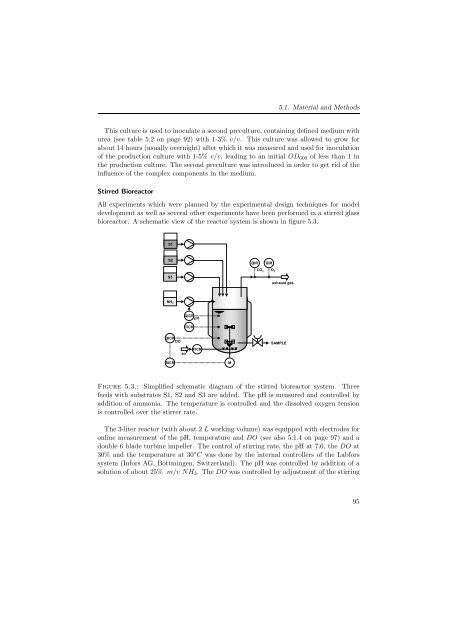Corynebacterium glutamicum - JUWEL - Forschungszentrum Jülich
Corynebacterium glutamicum - JUWEL - Forschungszentrum Jülich
Corynebacterium glutamicum - JUWEL - Forschungszentrum Jülich
Create successful ePaper yourself
Turn your PDF publications into a flip-book with our unique Google optimized e-Paper software.
5.1. Material and Methods<br />
This culture is used to inoculate a second preculture, containing defined medium with<br />
urea (see table 5.2 on page 92) with 1-3% v/v. This culture was allowed to grow for<br />
about 14 hours (usually overnight) after which it was measured and used for inoculation<br />
of the production culture with 1-5% v/v, leading to an initial OD600 of less than 1 in<br />
the production culture. The second preculture was introduced in order to get rid of the<br />
influence of the complex components in the medium.<br />
Stirred Bioreactor<br />
All experiments which were planned by the experimental design techniques for model<br />
development as well as several other experiments have been performed in a stirred glass<br />
bioreactor. A schematic view of the reactor system is shown in figure 5.3.<br />
S1<br />
S2<br />
S3<br />
NH 3<br />
QICR<br />
DO<br />
SICR<br />
QICR<br />
pH<br />
air<br />
TICR<br />
FICR<br />
M<br />
QIR QIR<br />
CO 2<br />
O 2<br />
exhaust gas<br />
SAMPLE<br />
Figure 5.3.: Simplified schematic diagram of the stirred bioreactor system. Three<br />
feeds with substrates S1, S2 and S3 are added. The pH is measured and controlled by<br />
addition of ammonia. The temperature is controlled and the dissolved oxygen tension<br />
is controlled over the stirrer rate.<br />
The 3-liter reactor (with about 2 L working volume) was equipped with electrodes for<br />
online measurement of the pH, temperature and DO (see also 5.1.4 on page 97) and a<br />
double 6 blade turbine impeller. The control of stirring rate, the pH at 7.6, the DO at<br />
30% and the temperature at 30 ◦ C was done by the internal controllers of the Labfors<br />
system (Infors AG, Bottmingen, Switzerland). The pH was controlled by addition of a<br />
solution of about 25% m/v NH3. TheDO was controlled by adjustment of the stirring<br />
95

















